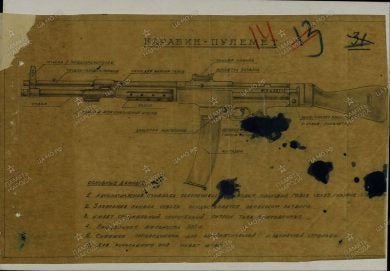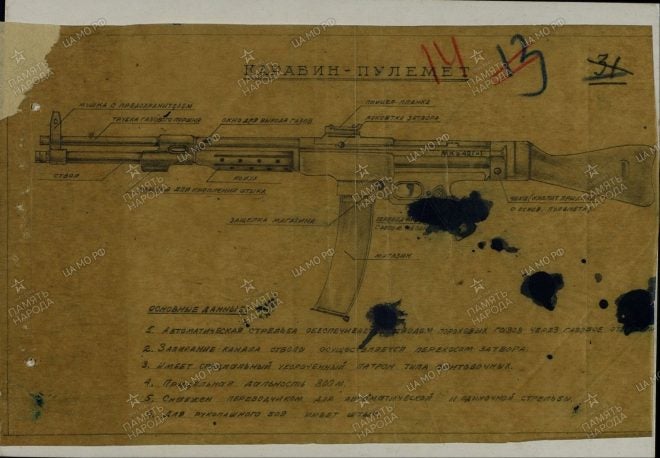A new class of weapon, the assault rifle, was adopted by Germany during the Second World War. Initially, this weapon had a greater impact on global affairs as propaganda, while bolt action and semi-automatic rifles still dominated the battlefield. Later, the assault rifle concept became the standard military rifle the world over.
During and after the war, Sturmgewehre (plural of Sturmgewehr) were captured by both the Soviets and the USA. In 1943, the USSR immediately launched an R&D program for its own assault rifle. As a result, by 1944 the Red Army had the prototype assault rifle created by Alexey Sudayev called the AS-44. A few years later, after a series of contests and selections, the USSR adopted the Kalashnikov.
Surprisingly it was not until the Vietnam war, two decades later, for an assault rifle – the M16 – to be adopted by the USA. The USA could easily have fielded such a weapon much more easily than they did. Therefore it essential to study the reports of the people who tested the first captured German Sturmgewehre rifles to understand the reasons behind such different views on the concept.
Due to the fact, that the first Sturmgewehre was tested by the Germans at the Eastern front, the Russians captured examples of the gun first.

Secret
Artillery command of
the North-West front Headquarters.
To the chief of the Main artillery department of the Red Army
Sending you via technician-lieutenant Troitsky N.N. a German carbine-machinegun and 4 cartridges, captured in June in area of 22nd army near city of Holm.
Soviet troops captured Mkb42(H) (Ger.: MaschinenKarabiner-42 (Haenel)) with a serial number 1334. It was most likely one of the prototypes by the Haenel factory, sent for testing to the 93rd infantry division, located at the Eastern front just by the city of Holm. There is also some evidence that the first gun with serial number 503 was captured earlier, but the is no documented proof of it today.
The “automatic carbine” reached the test facility of the Main artillery department accompanied by 2 pieces of ammo only. One of which was used to determine muzzle velocity (694 m/s), the second one – to study the rifle cycling process. The rate of fire, thus, had to be estimated – according to the test facility personnel it was to be around 470 rounds per minute.
As a result, the report of the first acquaintance of the Soviet armorers with the prototype of Shturmgewehr contained the following conclusions:
1. MKb42(H) carbine is of interest as a new type of weapon, relatively light (4.5kg – the weight similar to the weight of a semi automatic rifle) and, at the same time relatively powerful, capable of creating intensive and effective fire at distances up to 600 meters, which exceeds the submachine gun distances by far.
Small size and weight of ammo allow to carry 1.5-1.8 times the amount of machine gun ammo. Practical fire rate should be close to sub machine gun rate. The troops’ armament by this type of weapon can be in larger amounts, than with machine guns.
This is why a thorough test of the MKb42(H) rifle must and ammo must be carried out.
- The main feature of the MKb42(H) carbine is its ammo, the characteristics of which stand between rifle and pistol ammo. The shell varnishing and metal primer notch are of particular interest.
The question of manufacture of this cartridge is successfully solved by the Germans, as the standard rifle cartridge was taken and reinforced and repressed.
- Design-wise the MKb42(H) carbine is closer to hand machine gun. Its stamped design is of particular interest. The high quality of the stamp manufacture, spot welding and receiver rolling into a stamped box draw special attention.
Another feature is the axis and pins ends’ rolling just like the trigger box rolling prevent disassembly.
Butt stock endplate attachment is extremely weak and forces to assume that the rifle doesn’t cycle at full blow back power. Unfortunately, the lack of ammo didn’t allow to proceed with determination of the normal rifle cycling rate.
Another design flaw is difficult receiver access for repair (misfire, shell extraction etc).
Test firing with velocity meter indicates bolt unlocking under significant pressure. This should be regarded as a flaw at low fire rate (at high rate this is inevitable).
Full study of design and battle capabilities is only possible after a complete series of tests.”
Let us run ahead a little at this point. As it is evident from the citation above, the Soviet specialists realized that stamped design is more technological and cheaper than the milling method of production – it wastes a lot of metal, cutting machinery, expensive types of special steel, complicates the process etc. As early as before the Second World War the chief of the Main Artillery Department claimed: “I don’t need a milled firearm!” All the new weapon test carried out during the war mentioned the need to lean towards stamped firearm production. The Sudaev submachine gun – PPS is one of the successful examples of this.
In 1943, having had carefully studied the captured prototype, USSR promptly launched research and development of the intermediate ammunition and the firearm for it. Tech requirements were given out for several types of weapons: semiautomatic carbine, “heavy assault rifle” and belt-fed light machine gun.
However, the designers had to come up with firearms for a new cartridge that virtually didn’t exist yet. The problems with the launch of initial production had further delayed the tests of the prototypes. According to Main Artillery Department’s reports, it took at least 300,000 rounds of new ammunition to carry out factory tests. whereas by the end of 1943, only 10,000 were manufactured, and another 28,000 in January of 1944. But even these cartridges didn’t meet the technical requirements in ballistics and had other flaws (low gunpowder load, hard extraction, wrong dimensions etc).
It is interesting that among one of the reasons for the future development of assault rifles was Soviet commanders’ dissatisfaction with the MG-34 machine gun. According to Main Artillery Department officers’ opinion, the gun turned out to be too heavy for a hand machine gun, and for a stationary one it lacked the ability of easy barrel change. The Soviet soldiers that had faced the new Sturmgewehre also remarked on its weight and limitations – it is rather a version of handheld machine gun than rifle, can be implemented in 2-3 units per squad and by no means replaces the submachine gun.
Meanwhile, Soviet forces had started to capture not only the MKb42, but the MP 43/1, and further – the Sturmgewehr StG44 itself. However, by that time the Main Artillery Department’s fears had started to vanish – even though the amount of “automatic carbines” had increased, the Germans no longer had the capability to re-arm their whole infantry with them.
The reaction towards Sturmgewehr was much more indifferent in the USA. According to the Tactical and Technical Trends bulletin from April 1945, the name Sturmgewehr claims to erase the memory of the low quality of the previous versions of MPs, but the only real difference of the MP44 from the MP43 was the ability of attaching the standard rifle grenade launcher to it.
American experts believed the Sturmgewehr was the result of a German war effort in crisis. The weapon had limited effectiveness, they felt, due to trying to combine accuracy, firepower, and mass production capabilities in one firearm. According to their reports the, stamped design could be easily damaged and put out of service. Moreover, the StG 44 is unstable at full auto fire, this is why in most manuals it is recommended to stick to single fire and use full auto only in case of emergency. In US professionals’ opinion the, full auto option was of no use in this case as it was packaged with an additional 50% weight increase compared to their own intermediate cartridge rifle – the M1 Carbine.
The final conclusion of the US experts stated that the Sturmgewehr is a bulky, uncomfortable firearm, conceding to the M1 Carbine in terms of ease of use and reliability. In their opinion the, design of the Sturmgewehr was dictated by the production capabilities, rather than the needs of the military. They felt that the adverse situation in Germany forced them to produce a far from ideal firearm, rather than an automatic carbine of a more successful design.
The reason behind these opinions was the fact that the US military had the M1 Garand and the M1 Carbine at its disposal. The Garand beat the Sturmgewehr in range and ballistics. The ability to use full auto in case of emergency was not regarded as priority. It was considered that high accuracy at long and medium ranges was much more important. Even though the later M14 rifle did receive a full auto mode, it still remained a rifle for full power 7.62mm ammunition. Moreover, the experience of World War 2 and Korean war indicated that in time of battle stress, a regular soldier is unable to use all potential of his firearm. Meanwhile, however, the full auto role turned out to be important in case of repelling the Korean and Chinese communists’ attacks.
Maybe if the concept of an assault rifle had drawn more attention to it in 1944 and 1945 the US army would have got its own Sturmgewehr analogue in Korean war.
Andrey Ulanov.
Sources:
U.S. military report describing the German MP 44 assault rifle is taken from U.S. War Department publication Tactical and Technical Trends, No. 57, April 1945
materials from TsAMO (Central Archive of the Ministry of Defense RF) f. 38, op. 12040
 Your Privacy Choices
Your Privacy Choices
